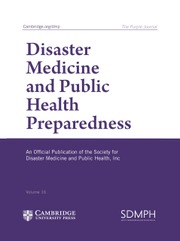To the Editor,
Soon after the nuclear disaster at the Fukushima Daiichi nuclear power plant [FDNPP], public information broadcasts suggested preventive behavior against radioactive contamination.1–4 However, these broadcasts disseminated information using unfamiliar language and many technical terms.Reference Miyawaki and Fukuda5 We attempted to compare health knowledge of radiation and preventive behaviors between people who had difficulty understanding the information about the FDNPP disaster and those who did not in a population of working adults in Fukushima after the nuclear disaster.
We conducted a cross-sectional questionnaire survey among general workers 3 to 5 months after the nuclear disasters in Fukushima.Reference Kanda, Hayakawa and Koyama6 The subjects were participants who took part in health seminars at the Fukushima Occupational Health Promotion Center [FOHPC] between June and August of 2011. Of 1282 respondents, 163 responses lacked complete data needed for analysis, leaving 1119 eligible responses in the study. Before the start of each seminar, the questionnaires were distributed and collected by the staff at the FOHPC. The questionnaire consisted of 3 sections to elicit the following: (1) if the information about the FDNPP disaster was difficult to understand, (2) basic knowledge of radiation-related diseases, and (3) preventive behavior against radioactive contamination. To compare means and frequencies of the variables, t-tests were used for continuous variables, while χ2 tests were used for categorical variables. A multiple logistic regression analysis was used for the contribution of each independent variable of those who had difficulty understanding the FDNPP information. The Statistical Package for the Social Sciences (SPSS, version 21.0J) was used to conduct the analyses.
Of the eligible respondents, 98 working adults reported having difficulty understanding the FDNPP information and 1021 adults did not. After statistical analysis of the variables, findings showed that those who had difficulty understanding the FDNPP information tended to be women, with the main source of information being neighbors or coworkers/supervisors and less information from using the Internet. All other types of radiation-related diseases and preventive behaviors were chosen with the same prevalence by both groups. Only having knowledge of the response “leukocytopenia” was statistically significant (P < .01). The Table shows the odds ratio and 95% confidence interval for those having difficulty understanding the FDNPP information, using logistic regression analysis. Statistically significant findings were being female and receiving the main source of information from neighbors and coworkers/supervisors; inverse significance was found with both Internet usage and knowledge of leukocytopenia.
Table Odds Ratios and 95% CIs for Having Difficulty Understanding Information About the Fukushima Daiichi Power Plant Accident (FDNPPA)Footnote a

a Analysis on 98 respondents among general workers in Fukushima 3 to 5 months after the nuclear disaster.
To our knowledge, this report is the first to assess health knowledge of radiation and preventive behaviors of those who have difficulty understanding the information about radiation in a general adult population during a nuclear disaster. Our findings showed that strong commitment in daily life to neighbors and coworkers might be helpful to disseminate information about health and preventive behaviors in an emergency. These factors may help to determine important strategies for distributing effective information about radiation in advance of or soon after a nuclear disaster.
There are some limitations in the present study. First, these results include a selection bias, as only participants of a health seminar were targeted. Also, a self-reported survey was used to determine if respondents had difficulty understanding the information about the FDNPP or not.
In conclusion, we found in a population of working adults in Fukushima that those who had difficulty understanding the information about the FDNPP were able to acquire health knowledge about radiation and act in an appropriate manner in a postdisaster environment. Our research should help in determining useful methods to reach all people, in spite of their levels of understanding, if a nuclear accident were to occur in the future.



